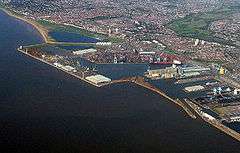Seaforth Dock
| Seaforth Dock | |
|---|---|
 Aerial view of Seaforth Dock | |
| Location | |
| Location | Seaforth, Liverpool, United Kingdom |
| Coordinates | 53°27′33″N 3°01′30″W / 53.4592°N 3.0250°WCoordinates: 53°27′33″N 3°01′30″W / 53.4592°N 3.0250°W |
| OS grid | SJ319963 |
| Details | |
| Owner | The Peel Group |
| Operator | Mersey Docks and Harbour Company |
| Opened | 1971[1] |
| Type | Wet dock |
| Purpose | Cargo transfer |
| Joins | Gladstone Dock |
| Entries | 1 |
| Gates | 1 pair |
| Area | |
| Width at entrance | 130 ft (40 m)[3] |
| Minimum depth | 50 ft (15 m) |
| Quay length | 10,000 ft (3,000 m)[2] |
| Cranes |
|
| Cargo type | |
| Transport links |
|
Seaforth Dock (also known as the Royal Seaforth Dock) is a purpose-built dock and container terminal, on the River Mersey, England, at Seaforth, to the north of Liverpool.[4] As part of the Port of Liverpool and Liverpool Freeport, it is operated by the Mersey Docks and Harbour Company. Situated at the northern end of the dock system, it is connected to Gladstone Dock to the south, which via its lock entrance provides maritime access to Seaforth Dock from the river.

History
Despite planning permission having been obtained almost sixty years previously, work commenced during the 1960s on Liverpool's largest dock facility. The dock was the largest built in the United Kingdom for some time, with 10,000 ft (3,000 m) of quay and a depth of 50 ft (15 m) and world's largest lock gates.[2]
Opened in 1971,[1] the site consists of about 500 acres (2.0 km2),[2] of which 85 acres (34 ha) is water,[1] and deals mainly in containers, oils, timber, fruit and vegetables, grain and animal feed. The dock became a free port in 1984.[5]
A fruit and vegetable terminal opened at the dock in 2008. The terminal primarily received produce from Spain. However, this facility closed in 2013.[6]
Wind turbines
In 1999, Peel Energy installed six Vestas V44-600 kW wind turbines along the river wall for a total nameplate capacity of 3.6MW.[5][7]
Improved rail connections increase throughput
Approximately 70% of North West England's freight passes through Liverpool. Seaforth container terminal is the prime container terminal for North America. Seaforth Dock is served by one rail line, the Canada Dock branch line. The Olive Mount rail chord at Edge Hill junction was re-opened early 2009 to increase the throughput of the service to Seaforth Dock by approximately 100%. The chord gives direct access for freight from the Port of Liverpool to the West Coast Main Line. The chord also releases line capacity for a proposed partial re-use of the line for passengers serving mainly the proposed Liverpool F.C. Stanley Park Stadium. There are no proposals to extend passenger services to Seaforth Dock.
The reinstatement of the chord was essential for existing port operations and ready for the 100% increase in freight when the planned Post-Panamax container terminal extension is ready at Seaforth Dock. A high throughput on the Canada Dock branch rail line is essential for efficient port operation.
It is hoped the Olive Mount rail chord reinstatement will remove large road vehicles from congested areas around the port and major road junctions, such as Switch Island, giving many environmental benefits.
Liverpool2
Liverpool2 is a Post-Panamax container terminal extension. The terminal was in the process of a phased opening by August 2016,[8] and would be able to berth up to 95% of the global container vessel fleet,[9] on the tidal River Mersey, adjacent to the Seaforth Dock. These ships transport up to 14,000 containers per ship. The facility will increase container throughput by 100%.
References
- 1 2 3 4 Pollard & Pevsner 2006, p. 278
- 1 2 3 4 Agar, M.; Irwin-Childs, F. (1973). "Seaforth Dock, Liverpool: Planning and Design". Proceedings of the Institution of Civil Engineers. 54 (2): 255–274. doi:10.1680/iicep.1973.4931.
- ↑ "Seaforth Passage - Port of Liverpool" (PDF). PIANC. p. 7. Retrieved 24 August 2016.
- ↑ "Royal Seaforth Dock History, Merseyside". Mersey Reporter. Retrieved 2 February 2016.
- 1 2 "Trading Places: Royal Seaforth Dock". Liverpool Museums. Archived from the original on 21 August 2008. Retrieved 21 July 2008.
- ↑ Hodgson, Neil (22 November 2011). "42 jobs axed with closure of Liverpool Produce Terminal at Seaforth depot". Liverpool Echo. Retrieved 2 February 2016.
- ↑ "Royal Seaforth Dock (Wind, Operating)". Interactive Map of Renewable and Alternative Energy Projects in the UK. Retrieved 5 October 2009.
- ↑ "UK Transport Minister Visits £400m Liverpool2 Development". Afloat. 16 August 2016. Retrieved 2 September 2016.
- ↑ "A New Deep Water Container Terminal". Peel Ports. Retrieved 1 August 2014.
Sources
- Pollard, Richard; Pevsner, Nikolaus (2006). Lancashire: Liverpool and the South West. Yale University Press. ISBN 9780300109108. OCLC 63396571.
Further reading
- McCarron, Ken; Jarvis, Adrian (1992). Give a Dock a Good Name?. Birkenhead: Merseyside Port Folios. pp. 76–77. ISBN 9780951612941. OCLC 27770301.
External links
| Wikimedia Commons has media related to Seaforth Dock. |